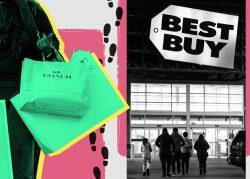Black Friday proved to be a mixed shopping bag for retailers across the country.
The traditional post-Thanksgiving consumer bonanza sparked more foot traffic than recent years as concerns about Covid declined, according to the Wall Street Journal. Despite the increase in store visits, however, sales didn’t jump in a statistically significant way.
Several firms that track shopper activity recorded increases in Black Friday traffic from last year. RetailNext, which counts shoppers via cameras and sensors, recorded a 7 percent increase year-over-year. Sensormatic Solutions, meanwhile, noted a 2.9 percent increase in foot traffic from last year.
Yet in-store sales were essentially flat from last year because the average shopper spent less per visit, according to RetailNext. Inflation’s impact was to blame for the static sales numbers, as well as anticipation of Cyber Monday deals.
Read more



Some consumers didn’t wait until Monday to score sales online. Black Friday sales increased 12 percent year-over-year according to Mastercard SpendingPulse, which includes both in-store and online retail sales, but excludes auto sales and isn’t adjusted for inflation.
“It’s more of an experience than it is a purchasing moment,” AlixPartners retail executive David Bassuk told the Journal, deeming Black Friday this year “lukewarm.”
Friday unfolded as retailers and their landlords were buoyed by positive signs about the sector’s bounceback from the pandemic. Retail availability dropped nearly a full percentage point across the nation to 5 percent in the third quarter, according to CBRE. It was the lowest level of availability in the firm’s 17 years of tracking.
Rising interest rates are slowing development in the sector, constraining supply. That dynamic is serving retail landlords and mall operators well in one sense, as the lack of space allows them to demand higher rents.
Sensormatic Solutions had recorded a 28.3 percent decline in retail traffic from 2019 to 2021 as Covid restrictions and fears decimated the annual shopping extravaganza and pushed consumers toward e-commerce instead.
— Holden Walter-Warner
